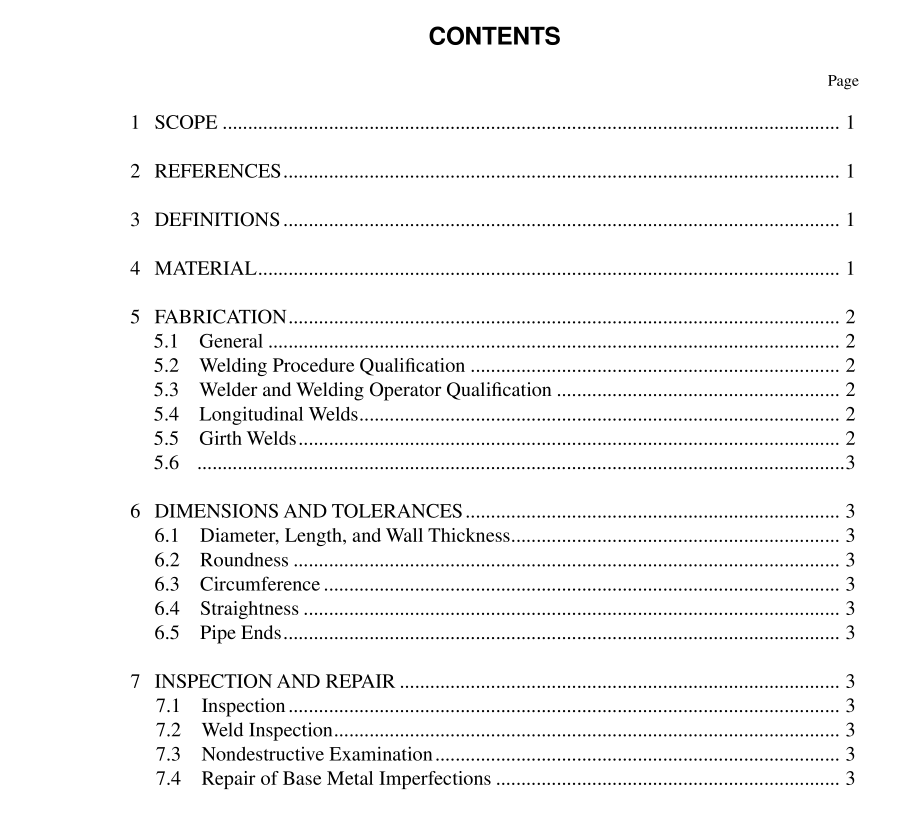API SPEC 2B pdf download

API SPEC 2B pdf download.Specification for the Fabrication of Structural Steel Pipe
1 Scope
1.1 This specification covers the fabrication of structural steel pipe formed from plate steel with longitudinal and cir- cumferential butt-welded seams, typically in sizes 14 in. out- side diameter (OD) and larger (40 in. and larger for LWDS) with wall thickness 3 / 8 in. and greater (up to a nominal 40 ft in length) suitable for use in construction of welded offshore structures. The use of the ERW process or spiral welded pipe is not included in this specification. Pipe fabricated under this specification is intended to be used primarily in piling and main structural members, including tubular truss connections, where internal stiffeners are not usually required. 1.2 Manufacturers desiring to apply the API Monogram to the products covered by this specification shall demonstrate to the satisfaction of the American Petroleum Institute a pro- gram of education, training, experience, and/or examination assuring the manufacturer’s personnel are competent in weld- ing, inspection, nondestructive examination, and testing required or referenced by this specification.
3 Definitions
For the purpose of this standard, the following definitions apply: 3.1 can: A section of structural steel pipe with no girth seam.3.2 fabricator: The person, firm, company, or corpora- tion executing the contract or agreement with the purchaser to fabricate the structural steel pipe under this specification. 3.3 girth weld: A circumferential butt-welded seam lying in a plane perpendicular to the longitudinal axis of the pipe, used to join tubular sections into lengths of straight pipe. 3.4 longitudinal seam: A butt-welded seam which par- allels the axis of the pipe. 3.5 longitudinally welded double seam (LWDS) pipe: A can with two longitudinal seams, one of which may be made in the flat plate condition. 3.6 manufacturer: The firm, company, or corporation- furnishing plate steel used in the fabrication of the structural steel pipe. 3.7 mill pipe: A structural steel pipe consisting of multiple cans joined by girth welds. 3.8 pile: A cylindrical tubular member fabricated from one or more lengths of structural steel pipe, usually driven through a leg or sleeve of an offshore platform, that carries vertical loads and resists lateral forces. 3.9 pipe weld: A longitudinal seam made after the plate has been formed into pipe. 3.10 plate weld: A longitudinal seam made between flat plates which are subsequently formed into pipe. 3.11 purchaser: The person, firm, company, or corpora- tion entering into a contract or agreement for the purchase of structural steel pipe fabricated under this specification. 3.12 single seam welded pipe: A can with one longitu- dinal seam, produced by a continuous welding process. 3.13 structural steel pipe : A cylindrical tubular mem- ber formed from steel plate, having a uniform material and wall thickness, with longitudinal and/or circumferential butt welded seams, comprising of the following types: can, single seam welded pipe, longitudinally welded double seam (LWDS) and mill pipe.
5 Fabrication
5.1 GENERAL 5.1.1 Forming pipe furnished to this specification shall nor- mally be formed below 400°F, that is, cold formed. Warm forming (between 800°F and 1200°F or 50°F below the tem- pering temperature of quenched and tempered steels) may be employed provided forming procedures for heat treated or TMCP steel are qualified to demonstrate the mechanical strength properties required by the original plate specification are met in the warm formed condition. Hot forming (above the upper critical temperature) may also be employed pro- vided the forming procedure is qualified to demonstrate all mechanical properties required by the original plate specifica- tions are met. 5.1.2 The purchaser may specify Supplementary Require- ment 1 if the rolled direction of the plate is desired to be ori- ented in a specific direction during the forming of the pipe, and the pipe shall be so identified. 5.1.3 All welding shall be in accordance with AWS D1.1- 2000, Structural Welding Code—Steel. Unless otherwise approved by the purchaser, the submerged arc welding pro- cess shall be employed for all welding—except tack welds, root passes and repair welding where other AWS approved processes may be utilized. All welds shall be complete joint penetration groove welds produced by employing AWS D1.1 prequalified joint details, or other joint configurations quali- fied by procedure qualification testing.









